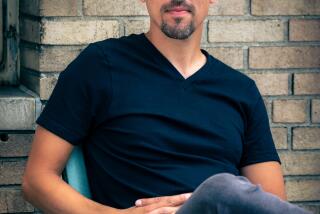The accordion holds a lofty place
- Share via
MOST people think of the accordion, if they think of it at all, as a social instrument, wheezing out polkas and folk tunes. The sound of it brings to mind French cafes, Mexican plazas, German beer gardens, Argentine nightclubs. Nick Ariondo, perhaps the premier accordionist in Los Angeles, notes that the instrument’s portability and its ability to play “everything: melody, chords and accompaniment” have made it popular all over the world.
But the accordion is not just an instrument of the people. As Samuel Zyman, a New York composer and a faculty member at the Juilliard School, puts it: “There is a significant serious classical repertoire written for accordion, plus an extensive catalog of transcriptions of piano, organ and orchestral works.”
Even Tchaikovsky used the concertina, a sort of hexagonal accordion, in one of his orchestral suites. Prokofiev included the accordion in his “Cantata for the Anniversary of the October Revolution.” And a quick look at the list of the dozens of works commissioned by the other AAA -- the American Accordionists’ Assn. -- reveals music by Henry Cowell, David Diamond, Lukas Foss, Virgil Thomson and Ernest Krenek.
FOR THE RECORD: An article about the accordion in the April 20 Calendar section said that accordionist Nick Ariondo had played for a Los Angeles Opera production of “The Threepenny Opera.” He played Kurt Weill’s Suite from “The Threepenny Opera” with the USC Thornton Wind Ensemble. In addition, it said player Carl Fortina succeeded Dominic Frontiere as music contractor at Paramount Studios; Fortina succeeded Phil Kahgan.
Like hem lengths, though, the accordion has been subject to fashion. Because it was cheaper and easier to make room for than a piano, there was a period a few decades back when children all over the world, particularly little boys, played the accordion. They included Zyman, 51, who began music lessons in his native Mexico City studying the instrument.
“The accordion is an amazing instrument,” says Ariondo, 58, who is also a composer and arranger. “It’s powerful, but it’s also delicate and sensitive. The public, when they really listen to it, are totally amazed. But let’s face it, the serious-minded people are reluctant about it.”
Indeed, nowadays the prevailing attitude may best be reflected by the popular bumper sticker “Use an accordion -- go to jail.”
However you view it, the accordion can seem like a contradiction in terms. Says Ariondo: “When you see the piano side of it, complete with white and black notes, you expect to see hammers, not valves. But this is a push-and-pull reed instrument. When you pull out on the accordion, you’re sucking air into it. It sounds like a harmonica. The bellows is like the bow on the violin. It’s very difficult to master.”
The surface of most accordions looks like mother-of-pearl, but actually, Ariondo says, “it’s celluloid, a very fine, high-profile plastic that’s very flammable. This thing is around a fire, boom -- it’s going to go up. But underneath is all wood. On a standard professional accordion, there are 448 reeds made of Swedish steel. They are attached to wooden reed blocks on the inside of the accordion and covered by the bellows. Tuning an accordion is a veteran’s job: Waxed-in reed plates are removed, cleaned and rewaxed; reed tongues must be filed to sharpen or flatten the pitch; and valve leathers need replacing. There are thousands of parts to this instrument. When I do the L.A. Opera or a concert, I have an extra one on the side, just in case something weird happens.”
Explaining why the accordion has made it into the classical world, Zyman notes that “like the organ, the accordion has different registrations that can make it sound like many different instruments, such as the flute, clarinet and bassoon, or even like an orchestral tutti. Moreover, the accordion has the ability to sustain the sound, to produce highly effective crescendos and to create a very expressive vibrato. None of this is possible on the piano.” Ariondo regards it as a “mini-orchestra.” All of which may make the accordion sound similar to a synthesizer, a creation from the end of the 20th century. But the first instrument called the accordion was patented in Vienna in 1829.
Playing the accordion can even suggest some chore from the Industrial Revolution. “If you don’t have the right training,” Ariondo says, “and you start pulling the bellows the wrong way, you can mess up the tendons in your arm. It’s very strenuous on your whole system. Everybody has to find ways to keep themselves from wearing out, a different angle.”
There are also, he points out, numerous varieties of accordion: “piano-accordions, concertina, the bandoneon” -- made famous by composer-bandoneonist Astor Piazolla, who took the Argentine tango to a new level -- “and the bayan, from Russia.” Zyman offers: “Perhaps the two most distinct kinds are one with a piano-like keyboard and another with buttons instead of keys for the right hand.”
The key is versatility
THE accordion is by no means universally ridiculed. Consider that, as played by Frank Marocco, it was the star of Michael Giacchino’s score for last year’s hit animated film “Ratatouille.”
Marocco, 77, is widely regarded as one of the great jazz accordionists and is the town’s top accordionist on studio dates, which might require him on any given day to play jazz, folk, pop or classical. He started the accordion at age 7.
Like Zyman, who at age 14 won a national accordion competition in Mexico, Marocco eventually “won a big contest” and “started playing a few jobs around town, weddings and birthday parties. I went on the road with my trio,” leaving his native Joliet, Ill., and wound up playing “the Vegas circuit -- Las Vegas, Reno and Tahoe -- where I learned to play almost every standard ever written: George Gershwin, Cole Porter, Jerome Kern, Duke Ellington.”
In 1959, he landed in Los Angeles, where he decided he had to “settle down and figure out how to make a living.”
“It was a very scary time,” he says. “Here I was in this big city, and I didn’t know anyone. The accordion was still popular. There were accordion studios around, so I took a job teaching. Los Angeles is a small town where musicians are concerned. They find out about each other. All of a sudden, someone said, ‘There’s a new accordion player in town, he’s really good.’ So I started getting a Saturday night job, a Sunday job, a Friday night. Pretty soon, I was working all the time, through word of mouth. I did a little bit of studio work during that time, but not a lot. There were guys ahead of me who were already established.”
Still, in 1965 Marocco was one of two accordionists on Maurice Jarre’s wildly popular orchestral score for the film “Doctor Zhivago.” The other was veteran Carl Fortina, who was enjoying a successful career playing for various TV series, including “Gunsmoke” and “Bonanza.” Then, in the late ‘70s, when Fortina succeeded another accordionist, Dominic Frontiere, as music contractor at Paramount Studios, the door into television opened for Marocco.
One of his early experiences was doing “The Waltons.” Composer Alexander Courage “would write for a small woodwind section that would have the flute, oboe, clarinet, bassoon and accordion. And he would write me little clusters -- two-, three-, four-note chords -- to blend in with the other woodwinds, so he had a nice, full woodwind section.”
Today, Marocco is busier than ever. In the three “Pirates of the Caribbean” films, “I played three different instruments -- accordion, bass accordion and musette. Michael Giacchino likes the accordion, so he wrote a lot of stuff for me to play.”
Yet Marocco observes that the accordion today is much more common in Europe than in the U.S. “In Germany alone, there are 3,000 accordion orchestras, with 30 or 40 players each. In America, we’re lucky if we have 3,000 accordion players.”
Falling into the wrong hands
IF a U.S. accordionist refers to his instrument as a “stomach Steinway,” “organ grinder” or “squeezebox,” it can be in a spirit of gentle self-deprecation. Often, however, “squeezebox” is not a compliment. And Marocco believes the reason is simple: “Most accordion players don’t play it the way it should be played. For every good player, there are 100 poor ones.” Part of the problem, Marocco acknowledges, is that “unlike the violin, with a few lessons you can immediately play a simple little song on the accordion. Unfortunately, most of the accordion players never took it much further. They learned to play a little polka, a little waltz, a march, and they’re satisfied.”
Among Los Angeles cognoscenti, by contrast, Marocco is considered a superb musician who just happens to play the accordion. In addition to his studio work, he plays in a group with L.A. Chamber Orchestra French hornist Richard Todd and with drummer Peter Erskine, bass player Michael Valerio and pianist Billy Childs. “I get a chance to have a lot of fun, besides making a living. Now it’s no longer about the money.”
Marocco enjoys the feeling of the instrument against him: “You’re breathing when you use the bellows.” He likens the player’s control to that of a singer -- which may help explain why the accordion has been used to provide accompaniment in a number of operas. With L.A. Opera, Ariondo has played for Kurt Weill’s “The Threepenny Opera” and “Rise and Fall of the City of Mahagonny.” In the company’s production of Samuel Barber’s “Vanessa,” he was onstage with violinist Armen Anassian playing an atonal waltz.
Then there is British bad boy Thomas Ades’ “Powder Her Face,” which Ariondo characterizes as “quite risque. I did it at USC, with the Long Beach Opera, and again in San Francisco with Kent Nagano. It is written for a chamber ensemble of 17 instruments. Ades had me play with everybody in the chamber ensemble. He understands that when you combine accordion with other instruments, magic starts to happen. I had to practice that thing so much to make things work. There are difficult concertos, like the Paul Kreston one, but as far as chamber music is concerned, that one takes the cake.”
Like Marocco, Ariondo plays in smaller ensembles as well. On May 22, he’ll be part of a concert at the Goethe-Institut Los Angeles showcasing his arrangements for accordion, viola and soprano of music by Beethoven, Schubert, Mendelssohn and others.
Every accordionist is used to people bringing up Gary Larson’s “Far Side” cartoon of a newcomer to heaven receiving a harp while, down below, the devil forks over an accordion. But like a hem length on the way out, that point of view may once again be growing dated. Just Google “accordion.” One of the more than 8 million results is the website www.AccordionHeaven.com.
More to Read
The biggest entertainment stories
Get our big stories about Hollywood, film, television, music, arts, culture and more right in your inbox as soon as they publish.
You may occasionally receive promotional content from the Los Angeles Times.










